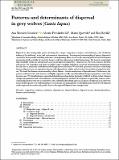Por favor, use este identificador para citar o enlazar a este item:
http://hdl.handle.net/10261/253121COMPARTIR / EXPORTAR:
 SHARE
BASE SHARE
BASE
|
|
| Visualizar otros formatos: MARC | Dublin Core | RDF | ORE | MODS | METS | DIDL | DATACITE | |

| Título: | Patterns and determinants of dispersal in grey wolves (Canis lupus) |
Autor: | Morales-González, Ana; Fernández-Gil, Alberto CSIC ORCID; Quevedo, Mario; Revilla, Eloy CSIC ORCID | Palabras clave: | Emigration transience Settlements Dispersal rate Dispersal distance Density-dependence human-caused mortality |
Fecha de publicación: | 2021 | Editor: | Cambridge Philosofical Society | Citación: | Biological Reviews of the Cambridge Philosophical Society | Resumen: | Dispersal is a key demographic process involving three stages: emigration, transience and settlement; each of which is influenced by individual, social and environmental determinants. An integrated understanding of species dispersal is essential for demographic modelling and conservation planning. Here, we review the dispersal patterns and determinants documented in the scientific literature for the grey wolf (Canis lupus) across its distribution range. We showed a surprisingly high variability within and among study areas on all dispersal parameters – dispersal rate, direction, distance, duration and success. We found that such large variability is due to multiple individual, social and environmental determinants, but also due to previously overlooked methodological research issues. We revealed a potential non-linear relationship between dispersal rate and population density, with dispersal rate higher at both ends of the gradient of population density. We found that human-caused mortality reduces distance, duration and success of dispersal events. Furthermore, dispersers avoid interaction with humans, and highly exposed areas like agricultural lands hamper population connectivity in many cases. We identified numerous methodological research problems that make it difficult to obtain robust estimates of dispersal parameters and robust inferences on dispersal patterns and their determinants. In particular, analyses where confounding factors were not accounted for led to substantial knowledge gaps on all aspects of dispersal in an otherwise much-studied species. Our understanding of wolf biology and management would significantly benefit if wolf dispersal studies reported the results and possible factors affecting wolf dispersal more transparently. | Versión del editor: | 10.1111/brv.12807 | URI: | http://hdl.handle.net/10261/253121 |
| Aparece en las colecciones: | (EBD) Artículos (IMIB) Artículos |
Ficheros en este ítem:
| Fichero | Descripción | Tamaño | Formato | |
|---|---|---|---|---|
| brv.12807.pdf | 1,22 MB | Adobe PDF |  Visualizar/Abrir |
CORE Recommender
PubMed Central
Citations
12
checked on 13-mar-2024
WEB OF SCIENCETM
Citations
23
checked on 24-feb-2024
Page view(s)
64
checked on 18-abr-2024
Download(s)
196
checked on 18-abr-2024

